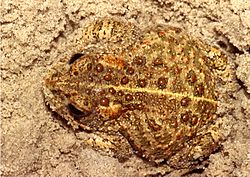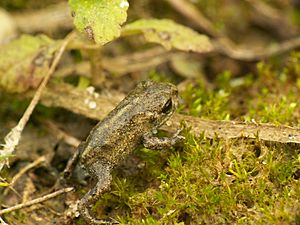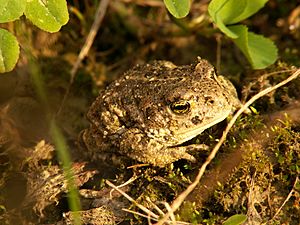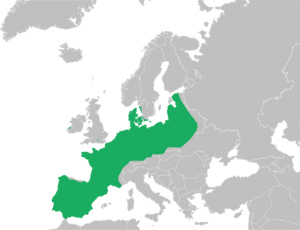Natterjack Toad facts for kids
Quick facts for kids Natterjack |
|
|---|---|
 |
|
| Conservation status | |
| Scientific classification | |
| Kingdom: | |
| Phylum: | |
| Class: | |
| Order: | |
| Family: | |
| Genus: |
Epidalea
Cope, 1864
|
| Species: |
E. calamita
|
| Binomial name | |
| Epidalea calamita (Laurenti, 1768)
|
|
The natterjack toad (scientific name: Epidalea calamita) is a special kind of toad found in Europe. These toads are usually 60–70 mm long, which is about the size of a small cell phone. You can easily spot them because they have a bright yellow stripe running down the middle of their back!
Unlike many other toads that hop, natterjacks have shorter legs, so they move with a unique, quick walk or run. They love living in sandy areas and heathland. Natterjack toads are also famous for their very loud and clear mating calls, which can be heard from far away.
Contents
Life Cycle of the Natterjack Toad
Natterjack toads can live for up to 15 years in the wild. They are active at night, moving across open ground where there isn't much plant life. If you look closely, you might even see their tracks in loose sand! These toads can travel long distances each night while searching for food.
Their diet mainly consists of insects, worms, and small reptiles. They are important predators in their habitats, helping to keep insect populations in check.
Reproduction and Young Toads
Natterjack toads usually lay their eggs, called 'spawn,' between late April and July. They lay these eggs in long strings in shallow, warm pools of water. Because there aren't always many natterjack toads in one place, their loud mating calls are super important. These calls help male and female toads find each other so they can mate.
The pools where natterjacks lay their eggs need to have a gentle slope and not too many plants growing on the banks or in the water. Sometimes, if the weather gets too hot, these shallow pools can dry up, and the young tadpoles might not survive. A female natterjack toad can mate a few times each summer. This means you might find young toads of different ages, from one month to three months old, by September.
Where Natterjack Toads Live
Natterjack toads live in seventeen different countries across Europe. In places like the British Isles, you'll mostly find them along the coast. However, in mainland Europe, especially in the southern parts, they live further inland in many different types of environments.
Natterjack Toads in Ireland
The natterjack toad is the only type of toad that is originally from Ireland. You can find them in specific areas like the Dingle peninsula and Derrynane in County Kerry. They are also found in County Wexford. Efforts are made to protect these special toads in Ireland.
Images for kids
See also
 In Spanish: Sapo corredor para niños
In Spanish: Sapo corredor para niños







